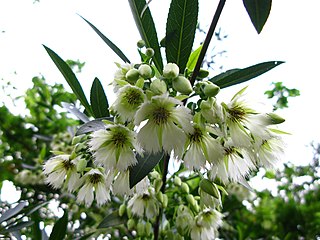
The Solomon Islands rain forests are a terrestrial ecoregion covering the Solomon Islands archipelago.

Elaeocarpus is a genus of nearly five hundred species of flowering plants in the family Elaeocarpaceae native to the Western Indian Ocean, Tropical and Subtropical Asia, and the Pacific. Plants in the genus Elaeocarpus are trees or shrubs with simple leaves, flowers with four or five petals usually, and usually blue fruit.

Jagera is a genus of 4 species of forest trees known to science, constituting part of the plant family Sapindaceae.

Intsia bijuga, commonly known as Borneo teak, ipil, Johnstone River teak, and kwila, amongst many other names, is a species of tree in the flowering plant family Fabaceae, native to coastal areas from east Africa, through India and Southeast Asia to Australia and the western Pacific. It has significant importance to indigenous cultures in many parts of its range, but is also threatened by illegal logging due to its high quality timber. It is most commonly found in tropical coastal forests.

The Trobriand Islands rain forests are a tropical moist broadleaf forest ecoregion of southeastern Papua New Guinea.

Barringtonia is a genus of flowering plants in the family Lecythidaceae first described as a genus with this name in 1775. It is native to Africa, southern Asia, Australia, and various islands of the Pacific and Indian Oceans. The genus name commemorates Daines Barrington.

Aglaia argentea is a species of plant in the family Meliaceae. It is a tree found in Australia, Brunei, India, Indonesia, Malaysia, Myanmar, Papua New Guinea, the Philippines, the Solomon Islands, and Thailand.

Vitex cofassus is a species of flowering plant in the family Lamiaceae. It is a tree native to Sulawesi, the Maluku Islands, New Guinea, Bismarck Archipelago, Solomon Islands, Caroline Islands, and Mariana Islands. "New Guinea teak" is planted for its hardwood, used in construction, in Indonesia, Malaysia, and the Philippines.

The Biak–Numfoor rain forests is a tropical moist forest ecoregion in Indonesia. The ecoregion covers the islands of Biak, Supiori, Numfoor, and several smaller islands, which lie in Cenderawasih Bay north of Yapen and New Guinea.
Dendrocnide peltata, commonly known simply as the stinging tree or jelaton, is a large tree in the nettle family Urticaceae. With the other species of the genus Dendrocnide, it is known for the stinging hairs which cover the whole plant and cause severe pain when touched. The Latin specific epithet peltata means "shield shaped", referring to the shape of the leaves.
Canarium vitiense is a rainforest tree species, of the plant family Burseraceae, growing naturally in Fiji, the Solomon Islands, Samoa, Tonga, New Guinea, Bismarck Archipelago, Admiralty Islands, Louisiade Archipelago, Torres Strait Islands and in lowland north-eastern Queensland, Australia.

Toona sureni is a species of tree in the mahogany family. It is native to South Asia, Indochina, Malesia, China, and Papua New Guinea. It is commonly known as the suren toon, surian, limpaga, iron redwood or the red cedar. It is also known as the Indonesian mahogany or the Vietnamese mahogany. The species is a valuable timber tree.

Sapindoideae is a subfamily of flowering plants in the soapberry family, Sapindaceae. It includes a number of fruit trees, including lychees, longans, rambutans, and quenepas.

The Vogelkop–Aru lowland rain forests is a tropical moist forest ecoregion in Indonesia. The ecoregion covers the peninsular lowlands of western New Guinea, along with the Aru Islands and other nearby islands.

Palaquium galactoxylum, commonly known as Cairns pencil cedar, Daintree maple or red silkwood, is a species of plants in the star apple family Sapotaceae which is endemic to rainforests of New Guinea and northern Australia. It can produce spectacularly large buttress roots.

Canarium indicum, known as galip nut, is a mainly dioecious tree native in eastern Melanesia. It is usually found in rainforests, secondary forests, old garden areas, around villages and settlements. It is also used as a shade tree, as a windbreak and in agroforestry. Canarium is important in the world food system as it can be used as a food and timber source, in traditional medicine, intercropping and agroforestry.
Spathiostemon javensis is a plant that can grow as a shrub or a tree in the tribe Acalypheae of the family Euphorbiaceae. It is native to the region from the Bismarck Archipelago to New Guinea, Wallacea and into Southeast Asia. It is often common in the understorey of forests. The wood is used in constructions.
Hopea novoguineensis is a rainforest tree species in the Dipterocarpaceae family. It is found in New Guinea and on Halmahera, Maluku Province, Indonesia. The tree produces good timber.
Pimelodendron amboinicum is a tree species in the Euphorbiaceae family. It is found from the Solomon Islands in the southwest Pacific, west to Sulawesi in Indonesia. The timber is used locally, though larger-scale illegal logging is apparent.

Pometia is a genus of 2 species of rainforest trees, constituting part of the plant family Sapindaceae.
















